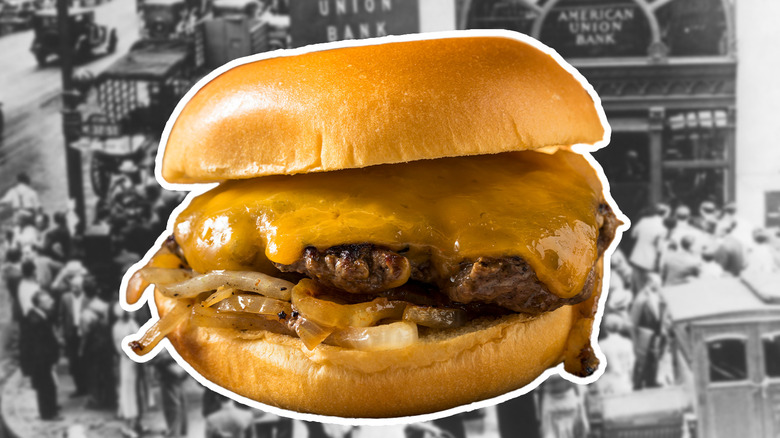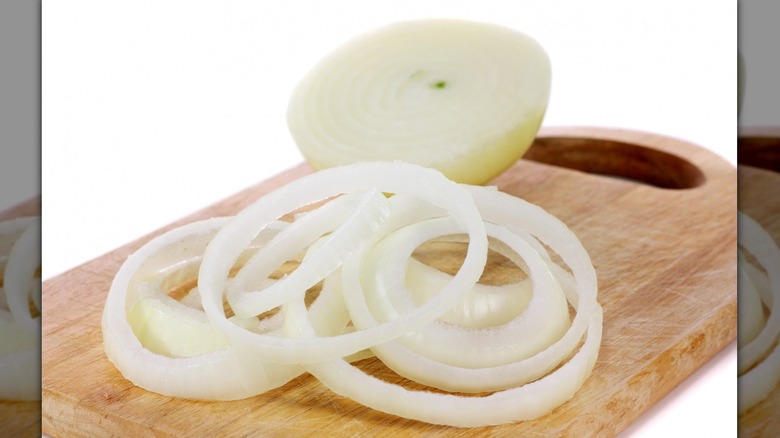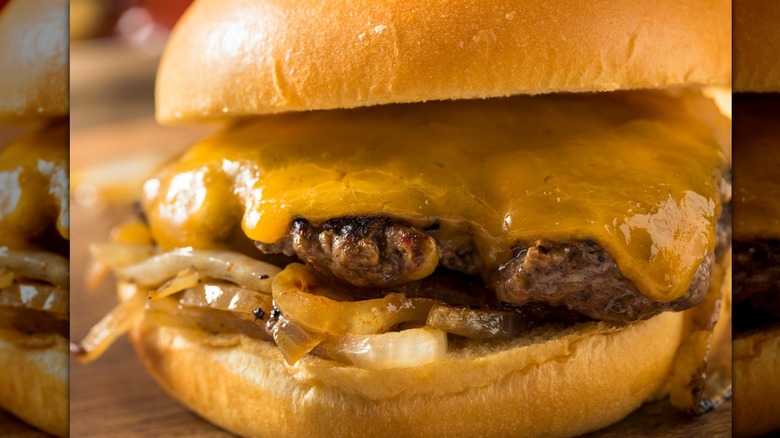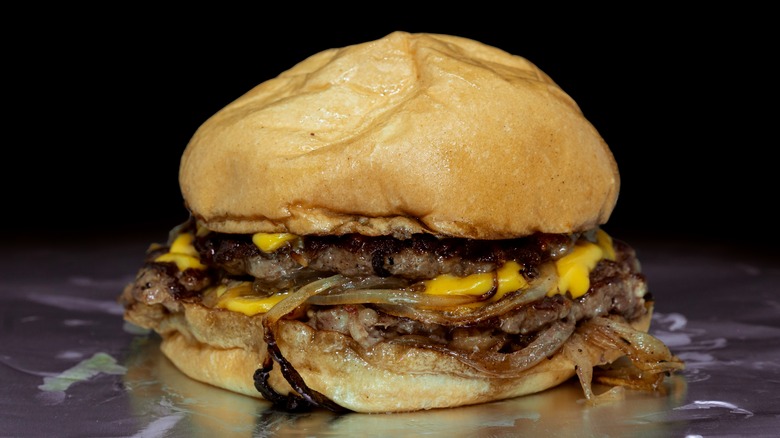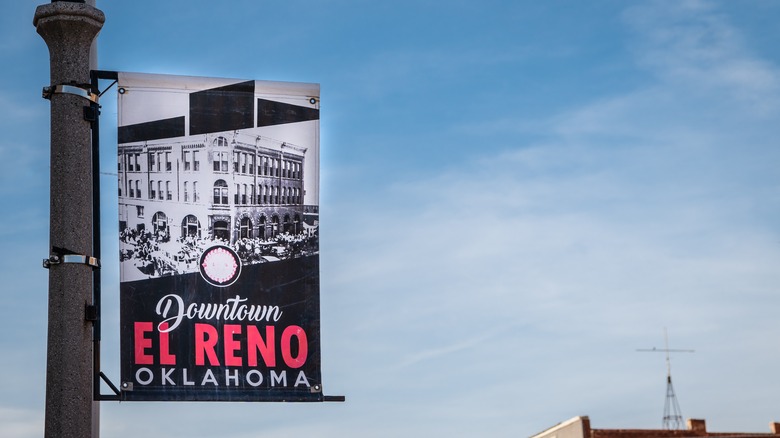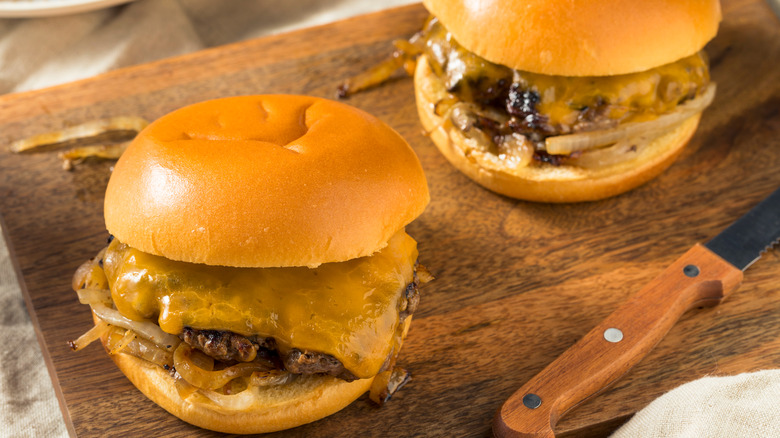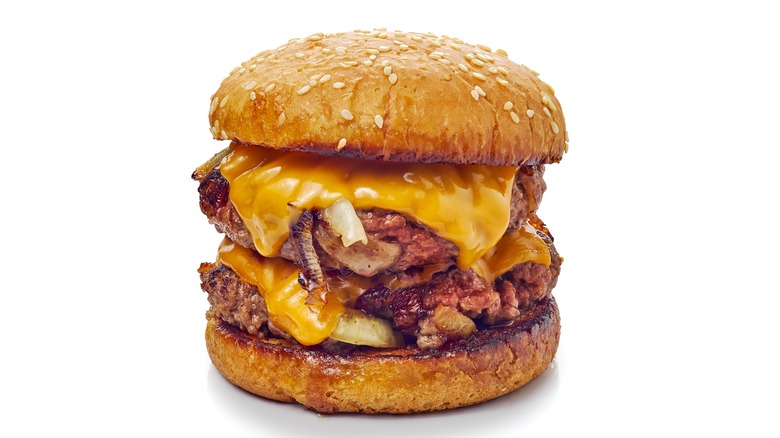The Depression-Era Origins Of The Famous Oklahoma Onion Burger
The Oklahoma Onion Burger holds a significant place in the state's history, symbolizing the enduring spirit of Oklahomans during the Great Depression. This iconic burger emerged from a challenging time, showcasing the resourcefulness and creativity of its creators. With caramelized onions and a savory beef patty merged together, the burger's simplicity is a testament to how a community, facing limited means, managed to craft a delicious and satisfying dish.
During the Great Depression, Oklahoma faced significant economic challenges due to a combination of factors, including a drought and plummeting oil prices. The impact was profound, leading to a sharp increase in unemployment that affected both urban and rural populations. Local communities grappled with the immense task of providing relief, relying on acts of charity and innovative solutions to meet the pressing needs of the unemployed.
Amidst economic hardships, Governor William H. "Alfalfa Bill" Murray strongly advocated for Oklahoma City's St. Anthony Hospital's soup line to continue, even in the face of opposition from local authorities worried about attracting non-residents. In a bold move to address the wider economic challenges, he declared martial law, effectively halting farm foreclosures. These historic events, documented by the Oklahoma Historical Society, portray the resolute efforts undertaken during that era to alleviate suffering and stabilize the region. Understanding the challenges of the Great Depression, how did a community facing adversity craft an iconic dish with such limited means?
Onions in Depression-era cuisine
The era of the Great Depression marked a substantial shift in American dietary habits, with onions becoming an ingredient in numerous dishes. This was largely due to their widespread availability and affordability, making them a practical choice for households dealing with the economic crisis. Larry O'Dell, director of communications and development at the Oklahoma Historical Society, explains to BBC that, "Everything was very expensive in Oklahoma during the Depression. But onions were cheap to grow."
Onions were commonly used in simple recipes such as potato and onion soup, offering nourishing meals for many who were facing economic hardship. Onions were also featured in more innovative recipes, an example being the peanut butter-stuffed onions promoted by the Bureau of Home Economics. Tasked with assisting Americans in creating affordable yet nutritious meals, the Bureau distributed recipes in newspapers and magazines. In this case, peanut butter was paired with onions in a recipe that prioritized nutritional value over conventional taste profiles.
The birth of the Oklahoma onion burger
In the late 1920s, the father-son duo of Homer and Ross Davis established the Hamburger Inn in El Reno, Oklahoma. Situated along the renowned Route 66, this diner catered to the needs of travelers journeying between Chicago and Los Angeles. As the grip of the Great Depression tightened, the affordability of beef diminished, presenting a challenge for the burger-centric establishment. In response, Ross Davis devised a creative solution.
To make his burgers more cost-effective and accessible, Ross Davis began incorporating copious amounts of shredded onions into the hamburger patties. This inventive technique allowed him to stretch the limited meat supply while enhancing the flavor profile. The onions were pressed into one side of the patty, resulting in a flavorful combination of tender beef and crispy onions.
The introduction of these onion-infused burgers at the Hamburger Inn quickly gained traction among both local customers and weary travelers passing through. The distinct style of the fried onion burger soon caught the attention of other burger joints in the area, leading to its widespread adoption. The term "Depression burgers" became associated with this creation, reflecting inventiveness in a trying economic climate.
Preparation technique
To prepare an Oklahoma Onion Burger, a small portion of ground beef is placed on a preheated, high-temperature griddle. Generous amounts of thinly sliced onions — approximately half an onion — are added to the meat. Using a spatula, these onions are then pressed firmly into the beef. This pressing technique ensures thorough cooking and integration of the onions into the patty, resulting in a flavorful combination of well-done beef and caramelized onions.
The patty is seasoned with salt and pepper to enhance the overall taste. Once formed, the beef and onion mixture is pressed onto the griddle, creating a patty that extends beyond the bun. Cheese may be added if desired. While the patty continues to cook, the soft bun is placed on top, allowing it to absorb the aromatic flavors of the onions as it warms. The entire stack is carefully lifted, the bottom bun is positioned underneath, and the burger is served.
While the cooking process may vary slightly among different establishments or individuals, the fundamental steps — including the iconic pressing technique — remain consistent. This preparation method is a defining characteristic of the Oklahoma Onion Burger.
Nationwide popularity and emotional connection
The appeal of the fried onion burger has transcended state lines, with burger joints nationwide embracing its crispy and caramelized onion goodness. However, for Oklahomans, the fried onion burger represents more than just a sandwich — it embodies the state's history and evokes a sense of home.
Larry O'Dell, director of communications and development at the Oklahoma Historical Society, describes the profound connection Oklahomans have with the fried onion burger. In an interview with the BBC, he expressed his personal experience, stating, "We grew up on it. I grew up eating onion burgers. It's delicious for starters, but whole generations have grown up eating it. I don't know how to explain it other than that it feels like Oklahoma. It tastes like home."
El Reno's original fried onion burger joints, including Johnnie's Hamburgers and Coneys, Sid's, and Robert's Grill, continue to attract crowds of people seeking the classic Depression burgers. The Oklahoma Onion Burger holds a cherished place in the hearts of the community, with its popularity celebrated during the annual tradition of Fried Onion Burger Day. On the first weekend of May each year, the El Reno Main Street Association blocks off the streets as a massive crowd of thousands of enthusiastic attendees gathers to witness the fire department prepare an impressive 800-pound fried onion burger.
Cultural significance and legacy
As a key stop on the historic Route 66, El Reno takes visitors on a nostalgic journey through the golden era of American roadside culture, with vintage motels, classic diners, and quirky attractions dotting the iconic highway. The town's historical significance shines through sites like Fort Reno, a former military post on the frontier, providing visitors with a glimpse into its past.
El Reno also proudly embraces its unique culinary heritage with the iconic Oklahoma onion burger now being considered a national treasure.Today, this unique burger has become a draw for tourists. Renowned establishments such as Tucker's and Sid's Diner in El Reno have gained widespread recognition for their onion burgers. Visitors from all over the country seek out these destinations to experience the authentic taste and nostalgia associated with the dish.
While rooted in tradition, the Oklahoma Onion Burger has also seen an evolution over the years. Establishments have added their own unique twists to the classic recipe. For example, Tucker's is known for its use of Creekstone Farms beef, seasoning a patty three times throughout cooking, and toasting its buns separately on the grill.
Influence on American burger culture
Regarded by some as an early example of the smash burger, the Oklahoma Onion Burger has had a significant influence on American burger culture. The rise in popularity of smash burgers has been observed across numerous restaurant menus nationwide. This cooking technique, once met with culinary skepticism, is rooted in scientific principles, specifically the Maillard reaction.
By pressing the patty onto a heated surface, the increased surface area facilitates the Maillard reaction, where amino acids and sugars interact, resulting in the formation of numerous flavor compounds. This process enhances the overall taste and contributes to the desired crispy exterior of the burger.
Although there were initial reservations regarding this technique, the growing popularity of smash burgers has challenged conventional burger preparation methods. Even notable chefs, such as Gordon Ramsay, have come to appreciate the distinct flavors and qualities of smash burgers. Contrary to concerns about dryness, well-seasoned smash burgers retain their juiciness and offer a compelling variation to the classic beef patty. The success of the Oklahoma Onion Burger and the wider embrace of smash burgers demonstrate the harmonious fusion of culinary tradition and scientific understanding, shaping the evolving landscape of American burgers.
Contemporary interpretations
Contemporary interpretations of the Oklahoma Onion Burger have garnered attention and praise from influential figures in the culinary world. Renowned food influencer and author, Kenji López-Alt, wrote about his admiration for the burger's history and the science behind it in a comprehensive New York Times tribute article. The positive reception of his article demonstrates the burger's widespread appeal and how it motivates food enthusiasts to seek out the unique experience it offers. As seen in this Yelp page of Duke's Hamburger, a reviewer mentions, "I've wanted to try the fabled onion burger ever since Kenji wrote about it," illustrating the direct impact of Kenji's article on attracting new generations of fans of the Oklahoma Onion Burger, eager to experience this iconic dish for themselves.
George Motz, author of "Hamburger America" and host of the "Burger Scholar Sessions" series on YouTube, has also played a significant role in amplifying the burger's reputation. His YouTube videos and public appearances have introduced this classic burger to a broader audience, generating millions of views and solidifying its position in the modern culinary landscape.
